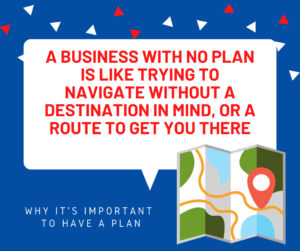To Fail to Plan is To Plan to Fail – not a new quote but do you really get what it means? The 10 Key Things Every Business Plan Should Have

A business with no plan has no direction, no structure and no real idea of the end goal. A bit like getting in a car and heading off in the general direction of somewhere without being clear on your destination, or your route, you’ll get there in the end, it may not be where you would like to be and there’s one thing for sure, it will have taken you far longer than it needed to. Every business needs a business plan. This is a working document and should be reviewed regularly. Yes, it might seem a lot of work but it is an extremely useful and important document to have, not least if you’re looking to secure investment whether from the bank or a board of investors. Putting your plan together definitely helps you get straight what you want your business to look like and how you are going to get there.
It is a document, not to be filed away to gather dust, but to be used as an operational document to be followed and regularly reviewed.
Now anyone can google the format of a business plan, the key is to tailor it to your business
There are 10 key things that your business plan needs to have.
- Executive Summary – an overview of your business and includes your mission statement and lists the products and services that you sell or plan to sell. If your business is new it might also include an explanation of why you’re starting it. You may find it easier to write the summary last. Doing so will mean you’ll have a clear picture of your plan.
- Business Description – This section needs to include a detailed description of your business, what your goals are, who your target clients/ customers are, what services and/or products you plan to offer. It’s important that you also include details of the industry you’re working in, key competitors and trends. It’s also important to include details of your experience in your chosen field and that of your team, if you have one.
- Market Analysis and Strategy – helps you to identify your target audience and where they can be found.
- Think about whether there are geographical factors, e.g. are you a beauty business looking to target customers within a 10 mile radius of your salon.
- What are the pain points experienced by your target customer – the product or service you offer isn’t currently available in your area. g feel rubbish about themselves – want to feel good, bad skin – would like better skin
- What are the needs of your target market and how do your products or services solve those needs. Keeping on the theme of beauty salons perhaps there are none locally or maybe there are but they don’t offer such high quality facials in such a relaxed atmosphere.
- The demographics of your target market
- Where do your target market spend their time – think about social media platforms, newspapers, magazines, radio, TV as well as local venues, cafes, libraries and parks.
Doing this analysis helps you to clearly define your target audience and make assumptions as to how well your product or service will perform.
- Marketing and Sales Plan – In this section you need to outline how you plan to sell and market your products or services to your target audience. Simple? Yes! However the devil is in the detail as they say. You need to include details of your
- Proposed marketing and promotion strategies – think about social media platforms you might use, events you might attend, leaflets and brochures you might need to produce.
- Pricing plans for your products and services
- Sales strategies
- Why your target market should purchase from you rather than your competitors -your unique selling proposition (USP)
- Plan for how you’ll get your product / service in front of your target market
- SWOT Analysis – Your plan needs to include a detailed Strengths, Weaknesses, Opportunities and Threats analysis, this should look at your strengths and weaknesses and set out how your business compares to competitors. The analysis should also include information on what makes your business different to that of your competitors, along with details of any challenges you may face when entering the market. Remember a weakness or a threat can be turned from a perceived negative into an opportunity, or a strength.
- Management and Organisation Description – In this section of your plan you need to set out who the key personnel are within your business, what their roles are and how they’re qualified to deliver them. . You may wish to detail the HR requirements and legal structure of your company. I suggest you present as a chart and do one now and others showing what you want it to look like at various key timelines along your business journey.
- Products and services description – This is where you can set out in more detail descriptions of the products and services you listed in your executive summary. You need to go into detail explaining how you’ll manufacture them, how long they last, and what it will cost to make them. If you’re a service provider then descriptions should be based on the services you sell, the supporting materials you have and the costs you incur in providing them.
- Operating Plan – This area sets out how you will operate your business, where it will be located, how many members of staff it will have, you may wish to include an organisation structure and an employee handbook.
- Financial Projects and Needs – This is where you should include financial details such as anticipated revenue and what funding you need to get started. If you’re an existing business then financial statements, balance sheet, profit and loss reports, and a cash flow projection. Remember start with the end in mind – work backwards initially.
- Appendices – In this section you should put together any supporting documentation that relates to your business. This could be product catalogues, your market research documentation, proposed or current marketing materials, legal and financial documentation.
If you’re an established business and are looking to put a formal business plan together/review the plan you already have, have a think about…..
- What you achieved and what you didn’t. If plans were changed because of the pandemic can they be re-introduced, or are they irrelevant and need changing?
- Goals that haven’t been completed? Why was this? Are they still relevant, if so be sure to include them in your plan
- Once you have updated your goals and objectives, your next step is to prepare a detailed plan for the next quarter of the year.
- This step is vital to your success. This is where you put the detail on the plan, listing the dates by which certain tasks need to be done and who will be doing them.
Need help getting your business plan down on ‘paper’, then click here to book a 121 with me and together we’ll get it sorted.
Doesn’t your business deserve to be given its best chance of success?







Reading your article helped me a lot and I agree with you. But I still have some doubts, can you clarify for me? I’ll keep an eye out for your answers.